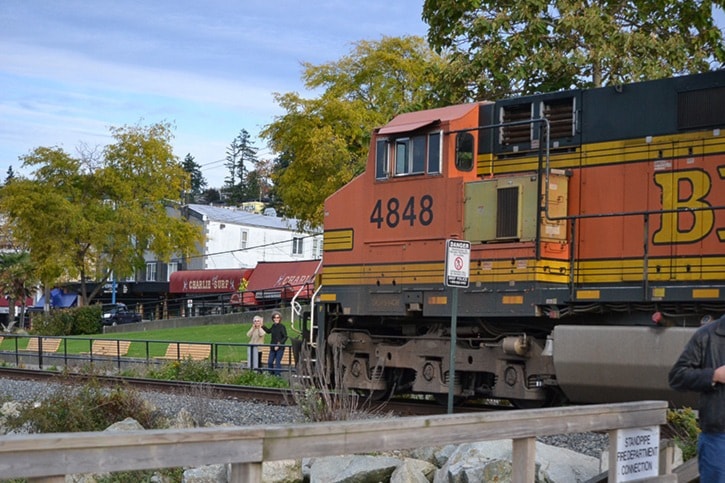White Rock officials forging ahead on the case for relocating the BNSF rail line off its waterfront have a number of factors on their side, council has heard.
According to Mary-Jane Bennett, a consultant hired to look into the application process, White Rock’s situation is less complicated than that faced by other Canadian communities in the past – meaning it should be an easier argument to win.
As well, pushing for an option that ultimately shortens the route for rail traffic along the BNSF line will improve the odds of convincing the rail company it is a good idea.
“When you’re reducing the time that a railway has to travel… you’re going to definitely find railway buy-in,” Bennett said, during an Oct. 20 presentation to council.
White Rock council voted in September to “initiate the process and application” for relocation of the BNSF tracks, in accordance with the Railway Relocation and Crossing Act; and, they approved spending up to $20,000 to hire Bennett for guidance.
 While Bennett’s report covered a range of issues that will have to be considered along the way, she focused her presentation on cost and timelines.
While Bennett’s report covered a range of issues that will have to be considered along the way, she focused her presentation on cost and timelines.
Key in the cost equation is a plan that ensures the railway neither gains or loses, she said. That means two cost estimates will have to be done: one on an exact duplication of the line at a new location, and one on the cost of constructing a new line that performs to a similar standard.
At a joint forum on rail safety hosted by Surrey and White Rock last November, four options for relocating the 19 kilometres of line that runs through the two cities were presented, including one paralleling King George Boulevard and Highway 99 that would see the line tunnelled between 16 and 36 avenues.
At that time, the cost of undertaking any of the four options was estimated at $350-450 million.
While Bennett said a committee that looks at community concerns should be created if tunnelling is the preferred option, Coun. Grant Meyer told Peace Arch News that no determination has been made regarding which routes to more definitively cost out.
He did say the tunnel option “would be the shortest.”
Bennett told council the financial plan for relocation should look at operating and maintenance costs over 15 years – again, with no loss or gain to BNSF.
Another advantage the city has in its argument for relocation, she said, is that the Canadian Transportation Agency – the body that would ultimately make the order to relocate the line – considers municipal staff the best people to be involved in project management, given their experience working with industry and other levels of government.
Regarding timelines, Bennett referred to a rail relocation in Regina. Involving two unwilling railways and the six-kilometre move of a “huge” rail yard, the “very complicated” effort took five years from the first meeting to the CTA order, she said.
“I do not anticipate this project would be at all in that nature,” she said.
While Bennett described the community’s case for relocating the line as “compelling,” she said one challenge may come in meeting a requirement for the provincial government and all affected municipalities to agree on two plans: an urban development plan and a transportation plan.
